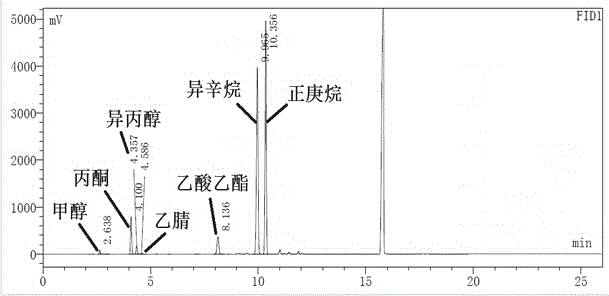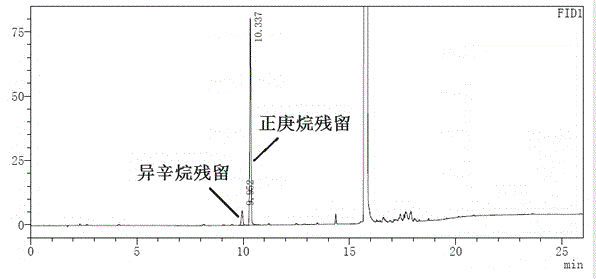Gas chromatography method for simultaneously detecting n-heptane, isooctane, ethyl acetate and isopropanol and use thereof
A gas chromatographic analysis and ethyl acetate technology, which is applied in the fields of pharmaceutical synthesis and chemical industry, can solve the problems of not being environmentally friendly, time-consuming and labor-intensive, and waste of detection reagents, and achieve the effects of stable retention time, good separation effect and high accuracy.
- Summary
- Abstract
- Description
- Claims
- Application Information
AI Technical Summary
Problems solved by technology
Method used
Image
Examples
Embodiment 1
[0028] Accurately weigh 0.1 g of the drug to be tested, put it in a headspace bottle, add 1 ml of dimethyl sulfoxide to dissolve it, seal it, and use it as the test solution.
[0029] In addition, accurately weigh the appropriate amount of isopropanol, ethyl acetate, isooctane and n-heptane, and add dimethyl sulfoxide to dilute to make a mixed solution containing 500 μg of isopropanol, 500 μg of ethyl acetate, and 500 μg of isooctane. , 500 μg of n-heptane reference substance solution.
Embodiment 2
[0031] The test solution and the reference solution were measured according to the residual solvent determination method (the second method of appendix VIIIP in the second part of the Chinese Pharmacopoeia 2010 edition), and the chromatograms of the reference solution were respectively obtained. figure 1 And the chromatogram of the test solution figure 2 . The test results are compared in the table below.
[0032]
Embodiment 3
[0034] Take 1mL of the test solution, put it in a 20ml headspace bottle, heat it at 80°C for 30 minutes, and then use the gas chromatography analysis method disclosed in the present invention to detect: the reagent sample is directly injected into the gas phase by manual injection. In the chromatograph, the injection volume is 1 μL. Using the DB-624 chromatographic column, set the initial temperature of the column temperature to 40°C, maintain it for 8 minutes, then raise the temperature to 220°C at a speed of 15°C per minute, and maintain it for 6 minutes; the temperature of the injection port is 250°C; the detector (FID ) temperature is 280°C; the carrier gas is nitrogen; record the chromatogram and get Figure 2 to Figure 6 .
[0035] Get 1mL of the reference substance solution, place it in a 20ml headspace bottle, heat it at 80°C for 30 minutes, and then use the gas chromatography analysis method disclosed in the present invention to detect: the test solution is directly ...
PUM
| Property | Measurement | Unit |
|---|---|---|
| volume | aaaaa | aaaaa |
Abstract
Description
Claims
Application Information
 Login to View More
Login to View More - R&D
- Intellectual Property
- Life Sciences
- Materials
- Tech Scout
- Unparalleled Data Quality
- Higher Quality Content
- 60% Fewer Hallucinations
Browse by: Latest US Patents, China's latest patents, Technical Efficacy Thesaurus, Application Domain, Technology Topic, Popular Technical Reports.
© 2025 PatSnap. All rights reserved.Legal|Privacy policy|Modern Slavery Act Transparency Statement|Sitemap|About US| Contact US: help@patsnap.com



